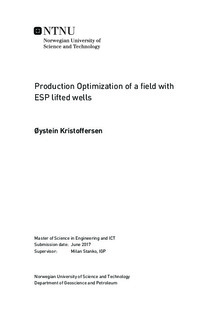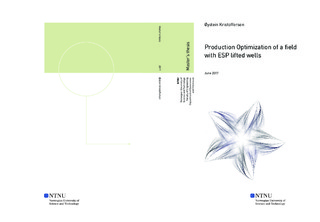| dc.description.abstract | Mathematical optimization is a set of techniques used to find the optimal points of some function given known constraints. This work aims to apply such techniques to find optimal production of oil from a network of wells where each wells have an ESP (Electric Submersible Pump) installed for artificial lift. The optimization model will attempt to optimize the total oil production while keeping constraints on water treatment capacity and local conditions at the pump. As optimizing non-linear functions is not efficient, a piecewise linear approximation (PWL) is created for oil rate as a function of frequency of the ESP for each well. This ensures linearity. Integer variables were introduced to the optimization model to turn wells on and off. The optimization model is then a MILP (Mixed Integer Linear Programming) problem, a well known class of problems in optimization theory that in practise can be solved efficiently compared to a non-linear MINLP problem, for which there exist is no general solving algorithm.
The scope of this work is to implement a optimization model in 2 different ways. First Microsoft Excel is used to optimize a 2 well network model where the production merges in a flow line. A third party add-on to Excel called OpenSolver is used to expand the optimization capabilities of Excel. In the second part the optimization model is implemented in AMPL. For this part, the optimization theory is applied on the Peregrino field offshore from Brazil. The field contains 27 producing wells. Pipesim is used as a reservoir model simulator in both parts, however for the Peregrino field the Pipesim model only contains one well, then single branch analysis is performed inputting data for each well in turn on the single branch model using a VBA macro in Excel. The optimization model for the Peregrino field is also slightly lower in complexity compared to the 2 well example field in part 1, as there is no common flowline to merge the flow from all the wells.
The optimization model implemented in AMPL for part 2 is successful. It provides optimal operating points for the ESP of each well while handling multiple operational constraints. All proposed cases ran without problem with very low runtimes. For part 1, OpenSolver in Excel struggled with many aspects of the proposed model. Many simplifications were made, including fixed $f_{ESP}$ and WC for both wells. In the end OpenSolver manged to solve the network, but the simplifications means the optimization model is too low in complexity to have practical application and finding optimal operating points. | |

